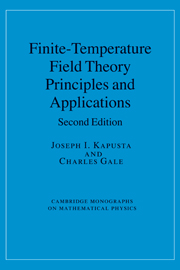
-
Select format
-
- Publisher:
- Cambridge University Press
- Publication date:
- 04 November 2009
- 03 August 2006
- ISBN:
- 9780511535130
- Dimensions:
- Weight & Pages:
- Dimensions:
- Weight & Pages:
You may already have access via personal or institutional login
Book description
The 2006 second edition of this book develops the basic formalism and theoretical techniques for studying relativistic quantum field theory at high temperature and density. Specific physical theories treated include QED, QCD, electroweak theory, and effective nuclear field theories of hadronic and nuclear matter. Topics include: functional integral representation of the partition function, diagrammatic expansions, linear response theory, screening and plasma oscillations, spontaneous symmetry breaking, Goldstone theorem, resummation and hard thermal loops, lattice gauge theory, phase transitions, nucleation theory, quark-gluon plasma, and color superconductivity. Applications to astrophysics and cosmology cover white dwarf and neutron stars, neutrino emissivity, baryon number violation in the early universe, and cosmological phase transitions. Applications to relativistic nucleus-nucleus collisions are also included. The book is written for theorists in elementary particle physics, nuclear physics, astrophysics, and cosmology. Problems are given at the end of each chapter, and numerous references to the literature are included.
Reviews
Review of the hardback:Praise for the first edition:'… an excellent introduction to the subject … Overall, this is still the only modern work in this area and it is the best place to start from.’
T. S. Evans Source: Contemporary Physics
Review of the hardback:'The material in this book is a well balanced introduction to the current literature on this subject. … This book … has already been a valuable resource to many workers in the field. With the advent of relativistic heavy-ion colliders this publication could not have come at a better time. Both graduate students and more experienced workers in this field should have a copy of this book on their shelves!’
Source: Journal of Physics
Review of the hardback:‘… a wonderfully compact book, filled with useful information and important references.’
R. Delbourgo Source: Mathematical Reviews
Review of the hardback:'… an excellent instrument for researchers; also, it could be used as a course in a PhD program.'
Source: Zentralblatt MATH
Contents
Metrics
Altmetric attention score
Full text views
Full text views help Loading metrics...
Loading metrics...
* Views captured on Cambridge Core between #date#. This data will be updated every 24 hours.
Usage data cannot currently be displayed.
Accessibility standard: Unknown
Why this information is here
This section outlines the accessibility features of this content - including support for screen readers, full keyboard navigation and high-contrast display options. This may not be relevant for you.
Accessibility Information
Accessibility compliance for the PDF of this book is currently unknown and may be updated in the future.


